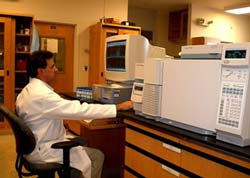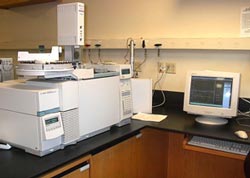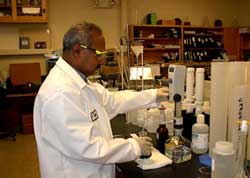
Volatile Organic Lab
EPA method 552.2
This is an analysis method for the determination of haloacetic acids. The nine haloacetic acids tested by the laboratory can be generated as disinfection byproducts from treatment of drinking water with chlorine. To analyze, these compounds are first extracted from water using microextraction techniques and then identified and measured by capillary gas chromatography using electron capture detector (GC/ECD).
EPA method 504.1
An analysis method for the determination of 1,2-dibromoethane (EDB) and 1,2-dibromo-3-chloropropane (DBCP) in water. To analyze, these compounds are first extracted from water using microextraction techniques, then separated by capillary gas chromatography and quantified by an electron capture detector (GC/ECD).
EPA method 524.2
This is an analysis method for the identification and simultaneous measurement of purgeable volatile organic compounds in drinking water in any stage of treatment. The method is applicable to a wide range of organic compounds that include the four trihalomethane disinfection by-products, MTBE (gasoline), tetrachloroethene (dry cleaning solvents) and toluenes (paint compounds). To analyze, the compounds are removed from drinking water using purge and trap techniques, and identified by mass spectroscopy.

Extractable Organic Lab
The Extractable Laboratory employs EPA drinking water to test for pesticides, herbicides, and a variety of industrial chemicals. The primary methods employed are 508A, 515.3, and 525.2.
Method 515.3 isolates acid herbicides and degradates from drinking water samples. Several popular herbicides are included in the method, which can detect contaminants down to fractions of a part-per-billion. Method 515.3 is an especially environmentally friendly method, creating much less waste than 515.1 and 515.2.
Gas chromatograph mass spectrometry (GC/MS) techniques are used to test for the variety of compounds included in Method 525.2. A liter of water is collected, treated, then carefully extracted and concentrated a thousand times. This sample is then analyzed for industrial chemicals, PCB's, plasticizers, and pesticides.
Any detected PCB's, which have not been detected in SCWA water, would be confirmed by EPA Method 508A, which uses an ultra sensitive electron capture detector to determine levels of concentration down to tenths of a part-per-trillion.
We will be developing two new methods, EPA 526 and EPA 528 to analyze for selected semi-volatile pesticides and herbicides, and phenols.

Wet Chem Lab
The following parameters are tested for in the Wet Chemistry Laboratory. Many of the methods performed in this laboratory are performed by hand:
- pH : a measure of acidity/causticity
- Conductivity : a measure of the ionic constituents in solution
- Turbidity : a measure of suspended matter
- Color : the relative clarity of the water. Color in water may result from the presence of natural metallic ions.
- Hardness(total) : the amount of calcium and magnesium in the water.
- Alkalinity(total) : the amount of carbonate, bicarbonate, and hydroxides in the water. The alkalinity of water is its quantitative capacity to neutralize a strong acid to a designated pH.
- Cyanide : determination of free cyanide to 5 ppb (5 ug/l).
- Surfactants : a liquid/liquid extraction is performed to concentrate non-soap anionic surfactants (Methylene Blue Active Substances)
- Ammonia (ammonium ion) : automated colorimeter of ammonia in drinking water in the range of 0.01 ppm to 1.00 ppm.
There are two fundamental techniques used in the Wet Chemistry Laboratory. Potentiometric measurements are used to determine pH, conductivity, and cyanide. This technique measures the difference in electron potential between a reference electrode and a measurement or "working" electrode. Color, turbidity, alkalinity, hardness, surfactants, and ammonia are all determined colorimetrically. Hardness and alkalinity are simple titrations where a sharp change in color of an indicator signifies the result. Measurements of color and turbidity are made at a specific wavelength of light. A calibration curve is used to calculate concentration from a measured transmittance or absorbance. In the case of ammonia and surfactants, chemicals called reagents are added to obtain a color change if any analyte is present. The darker the color change, the more analyte is present. Testing for raw materials used in treatment occurs in this laboratory for chlorine solutions, phosphate solutions, and virgin carbon testing.
Liquid Chromatography Lab
The Liquid Chromatography Lab is equipped with 4 liquid chromatography systems and 5 ion chromatography systems.
Three different liquid chromatography methods are used to analyze for the presence of herbicide and pesticide organic contaminants. Diquat and Paraquat samples are extracted and identified with a ultra-violet detector.
Glyphosate and the Carbamate pesticide samples are treated to form a fluorescent compound, which can then be detected with a fluorometer. We will be developing a new liquid chromatography method to analyze for phenylurea pesticides.
Ion Chromatography is utilized for the determination of bromide, chloride, fluoride, nitrate, nitrite, ortho-phosphate and sulfate using one analysis method. Within the last three years a new ion chromatography method was developed to test for perchlorate. Presently, we are developing a low-level perchlorate method.
Metals Lab
Thirty-two different elements (metals, metalloids) are simultaneously tested for on an inductively coupled plasma mass spectrometer (ICP/MS). We are currently analyzing for:
lithium, beryllium, boron, aluminum, silicon, phosphorus (as total phosphate), titanium, vanadium, chromium, manganese, iron, cobalt (mass 59), nickel, copper, zinc, arsenic, selenium, strontium (mass 88), molybdenum, silver, cadmium, tin, antimony, barium, mercury, thallium, lead, uranium (mass 238), sodium, potassium, calcium, magnesium.
Atomic Absorption Spectrometers (both Zeeman graphite furnace and flame) techniques are also used to test for these 32 elements.
Bacteriology Lab
There are two procedures used:
- Membrane Filtration: Determines the density of coliform bacteria, an indicator organism, which is used as the basic standard for bacteriological quality of water samples. This procedure tests the sanitary quality and effectiveness of treatments processes, like chlorination.
- Standard Plate Count: Determines the density of heterotrophic bacteria in treated water systems, such as where carbon filters are present.
Presently, we are developing a new method to monitor for Aeromonas. EPA requires this study for the UCMR List 2 microbiological contaminant monitoring program.